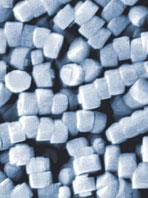A new way to make silicate nanoparticles that spontaneously self-assemble.
A new way to make silicate nanoparticles that spontaneously self-assemble has been developed by Stephen Mann at the University of Bristol, UK, and Kensuke Aoki from Asahi Kasei Corporation in Japan.
In a single step, identical building blocks align along one plane to give chains that can be joined to make much larger structures.

Preformed silicate nanoparticles are already used as building blocks in organised materials such as spheres, sponges and foams.
To date, reports of spontaneously-forming superstructures based on these organised materials are few and far between.
Mann and Aoki’s stable chains of silicate nanocrystals self-assembled in the presence of poly(diallyl-dimethylammonium chloride) (PDAC), a cationic polyelectrolyte. The crystals’ regularity lets them stack spontaneously at moderate PDAC concentration.
Using nanoparticle building blocks to construct higher-order architectures offers potential uses in electronics, photonics and information engineering areas where so far zeolite compositions have rarely been used in large-scale processes.
Suzanne Abbott
References
<man>b415155k</man>






No comments yet